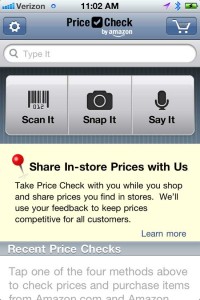
Amazon's Mobile Price Check App
By Steven B. Schweitzer
Amazon’s Price Check Mobile Phone App Serves as the Newest Threat to All Retailers
Big boxes know how you shop in their stores. They know your buying habits, your favorite store location, your favorite products, the time of day you spend the most money, and the list goes on. Now, Amazon’s new Price Check mobile phone app will know that too.
The app assures you are getting the best price on anything –seriously anything… just by taking a picture of it or scanning the barcode. OK, the price scanning feature isn’t new to mobile commerce, so what’s the rub? Amazon blatantly asks the user to share in-store brick-n-mortar prices with their mobile device. This is yet another foray into guerrilla marketing and pricing intelligence by someone other than a big box. Do you think Big Boxes like this? No. Do small retailers, like the fly shop owner, like this? No. What can you do about it? Nothing really.
Online Retailing Behemoths Are the New King of the Hill
Many retail pundits argue the price app gives the online retailer an unfair advantage over smaller competitors. Besides the obvious intel of price matching, the app can also give über-valuable geo-location pricing data – no other online retailer has this capacity for public and global data mining to-date. Why does the model work? Because the customer gets rewarded by seeing the lowest local price real-time, as the app promises. And, even though the retailing community is speaking out against Amazon, it’s still free press even if it’s bad press, and it all helps Amazon. Remember, savvy shoppers aren’t loyal, which is where Amazon makes bank. Ironically, many of the vocal nay-saying nationwide retailers also sell direct via Amazon. Hmmm.
Who Does This Benefit?
The price-conscious shopper reaps the reward, obviously. And, Amazon builds an exclusive ocean of data to evaluate the invaluable “four P’s” of marketing: Price, Promotion, Placement and Product. The rest of the selling world is under threat. Keep in mind that online retailers don’t pay sales tax unless they have a physical presence in a state. Combine this with the fact they have an assumed lower overhead (little to no real estate costs, no retail staff and management, less inventory, etc) and they become extremely price competitive, talking directly into the pocketbooks of the price-conscious public.
What’s Next?
I surmise we will see other online retail behemoths and even smaller retailers and independents to follow suit. The data is free, the retailer just needs to build an app to acquire it – it’s a no-brainer. It also cements the way price-sensitive shoppers spend their money. They’ll go to a brick-n-mortar to touch, feel and try on products. They’ll scan it and gain immediate intel on where to purchase it less expensively, even paying no taxes. They’ll buy it on their mobile device from an online retailer while standing in the brick-n-mortar store, or they’ll go home and fire up the desktop to shop in the comfort of their own home. Either way, consumers are now armed with a necessary shopping tool and brick-n-mortar stores just become showrooms for Amazon.
Don’t be surprised to see these types of apps merge with social media channels either. It’s hard to say how just yet, but word of mouth is the most powerful advertising tool, and social media gives significant viral horsepower to word of mouth endorsement.
And what about the online tax debate? Well, Amazon’s app just upped-the-ante for lawmakers to hasten their efforts to blanket yet another sales channel with a tax. Don’t be surprised to pay a consistent sales tax on online purchases in the future. That’s almost inevitable.
Consumers speak out too. Do a quick Google search on “Occupy Amazon” to see whether the consumer is fed up.
How Can You Compete?
Smaller retailers and local fly shops should continue to offer what Amazon can’t – an in-store experience with personality, education and infallible product knowledge. Visual merchandising tactics can also be employed to deter the use of price grabber apps – but only for so long. Ultimately, it will be the product line-up in your shop that determines if you will be bit by the price-snitching bug. If you carry product lines mostly exclusive to the fly fishing industry, such as popular waders and high-end rods and reels, then you won’t be affected too much. But if you carry more commoditized crossover items that can be found in other brick-n-mortar retailers, then “game on.”
No longer can fly shops sleep thinking they’ve killed the big box dragon – there’s a new fire-breathing threat in town, and it’s on every mobile phone.




2 Comments
“If you carry product lines mostly exclusive to the fly fishing industry, such as popular waders and high-end rods and reels, then you won’t be affected too much. But if you carry more commoditized crossover items that can be found in other brick-n-mortar retailers, then “game on.”
Now there is a recipe for disaster. Although the premise of your article is accurate, the remedy is appallingly wrong. All you are doing is recommending that each fly shop become a “cookie cutter” copy of the competition. Personally I like your advice because it makes it much easier for someone with an ounce of courage to embrace a distinction which will result in success. But your statement is totally misleading and could just as well have been paid for insertion by the “leading brands” in the industry.
The future of the industry is in the education of the new entrants via specialty shops and guides. To the extent that either a shop or a guide can distinguish it or himself a following will evolve which will sustain the business. The basic items you mention such as rods, reels, waders etc are merely commodities which usually are too expensive anyway. Gone are the days where there are only a few brands which will work. There is now a panoply of alternative offerings in the categories mentioned which are relatively indistinguishable from each other and are more reasonably priced. In this new era of modest consumption these will make headway, particularly where they are sold by the specialty shops and/or the guides.
Any attempt by the industry to control the sales of their products such as that mentioned in this edition concerning simms will fail. Either the manufacturers will make it so difficult for shops to survive they won’t carry the items or else they will find a way around it. There are a number of small smart operators now who are making a push into the industry and who are going to make an impact. And they are smart because they understand how the products are sold. And they are more cognizant of the business requirements of their clients.
It’s a new world. Things change. Deal with it.
The way to always beat bigger is by being better. Offer what they can’t, won’t or don’t understand. Usually, the box has no brain. Amazon isn’t much better or even different. They can’t offer custom orders for customers, local colors, unique items, interesting products or even brand new products. They also miss the start of trends and tend to follow, not lead. Much of the time when a trend has happened the boxes have already missed much of the move. I’ve always avoided doing what the box does. I compete by developing my own products, sources and hence my own prices. I can offer better goods at better prices and also items they don’t offer. If you go head to head with you’ll loose. Try being what they aren’t. I try to better at being me, not matching them.
If you offer a commodity, do it with a twist.